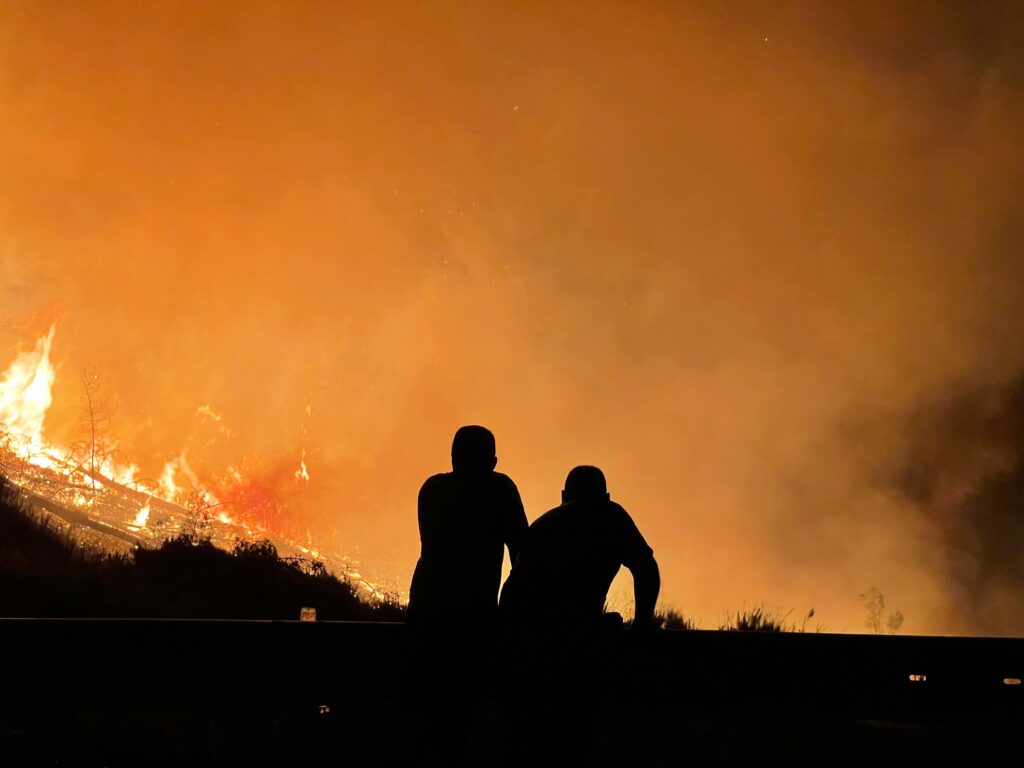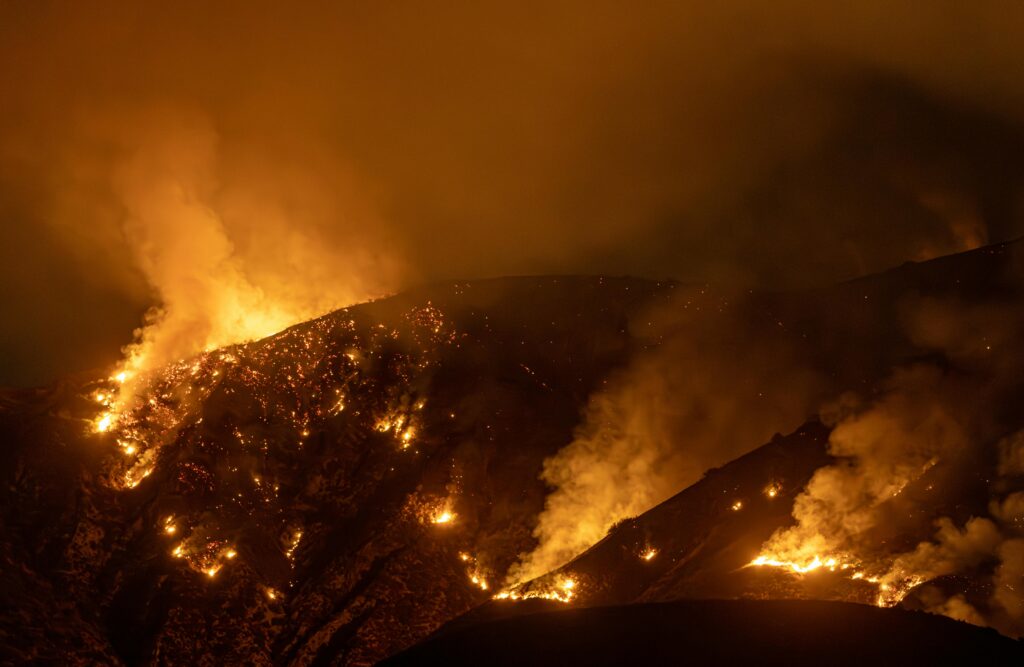California Wildfire 2025: A State on Fire
California is burning once again. The California Wildfire 2025 season has arrived with devastating force, and the flames are spreading across the state. From Los Angeles to the Bay Area and even near San Diego, wildfires are leaving destruction in their wake.
But why is this happening? Where are these wildfires, and what can be done to prevent them? Let’s break it down.
Los Angeles region
The Los Angeles region experienced unusually wet winters in 2022 and 2023, which led to an abundance of vegetation. However, the exceptionally dry winter of 2024 has caused this vegetation to dry out, turning it into fuel for wildfires. Climate change—marked by increased heat, prolonged drought, and a drier atmosphere—has significantly heightened the risk of wildfires in the western United States. Coupled with Southern California’s naturally fire-prone coastal shrublands, unpredictable weather patterns, low humidity, dry conditions, and strong winds have created extreme fire behavior. Recent offshore winds and minimal rainfall (less than 10% of the average since October 1) have further exacerbated the region’s wildfire risk.
California Wildfires in Los Angeles and the Bay Area: What You Need to Know
The California wildfire season of 2025 is creating challenges for both Southern and Northern California, with Los Angeles and the Bay Area at risk. Here’s a closer look at the wildfire situation in these regions.
California Wildfires in Los Angeles
Los Angeles, known for its sprawling urban landscape and scenic hills, is no stranger to wildfires. The dry, hot weather combined with strong Santa Ana winds creates the perfect conditions for fires to ignite and spread rapidly.
🔥 Current Situation
- Recent offshore winds have increased the wildfire threat around the Los Angeles foothills and San Gabriel Mountains.
- Communities near the city’s outskirts, such as Malibu and Topanga, are on high alert.
- Air quality has already worsened in certain areas due to smoke from nearby blazes.
🌟 Why Los Angeles Is Vulnerable:
- Dense vegetation from previous wet winters has dried out, acting as fuel.
- The proximity of urban developments to fire-prone shrublands increases the risk to homes and lives.

California Wildfires in the Bay Area
The Bay Area faces a unique wildfire challenge due to its mix of dense forests and urban areas. While coastal breezes can help reduce fire risk, the region’s unpredictable weather and growing population have heightened its vulnerability.
🔥 Current Situation
- Northern parts of the Bay Area, including Napa and Sonoma counties, have seen small fires in forested regions.
- Wildfire risks remain high in Marin County and areas around the East Bay hills, where vegetation is dense and the terrain is steep.
🌟 Why the Bay Area Is Vulnerable:
- Extended periods of dry weather and low humidity have created dangerous conditions.
- Growing urban sprawl into wildland areas, such as in the East Bay and North Bay, increases fire exposure.
California Wildfires: From San Diego to Northern California
Wildfire season in California continues to threaten communities across the state, from the southern regions of San Diego to the forests of Northern California. Here’s an overview of the current situation and what residents need to know.
San Diego California Wildfires
Although San Diego hasn’t been hit by major fires yet this season, it remains at high risk due to dry conditions and powerful Santa Ana winds.
- Current Risk: Offshore winds combined with parched vegetation make the outskirts of San Diego vulnerable, especially in areas like Escondido and the Cleveland National Forest.
- Past Impact: San Diego County has experienced devastating wildfires in the past, including the 2003 Cedar Fire, one of California’s deadliest.
🌟 What to Watch For:
- Stay alert for fire warnings in East County areas and near wildland-urban interfaces.
- Monitor local alerts from Cal Fire San Diego for updates.

Southern California Wildfires
Southern California, including Los Angeles, San Bernardino, and Orange County, is at the heart of the state’s wildfire risks.
- Why It’s Dangerous: Strong winds, hot temperatures, and drought conditions create a perfect firestorm. The dry vegetation from past wet winters is now highly flammable.
- Key Areas of Concern:
- The Santa Ana winds are driving fires toward urban areas.
- Fire-prone regions include Malibu, Topanga Canyon, and the San Bernardino Mountains.
🔥 Fire Safety Tip: If you live in Southern California, ensure you have an evacuation plan and defensible space around your home.
Northern California Wildfires
Northern California is no stranger to wildfires, especially in heavily forested areas like the Sierra Nevada, Shasta County, and Napa Valley.
- Current Wildfires: Several small fires have sparked near the Sacramento Valley and Mendocino National Forest, where dry conditions persist.
- Historical Impact: The August Complex Fire (2020) and Dixie Fire (2021) remain stark reminders of the region’s vulnerability.
🌟 Why the North is at Risk:
- Dense forests act as fuel for wildfires.
- Prolonged drought and high temperatures make conditions ripe for fire ignition.
Where Are the California Wildfires Today?
As of today, multiple wildfires are raging across the state:
- Northern California: Massive fires are blazing in the forested regions, fueled by dry winds and parched vegetation.
- Los Angeles: Fires near the outskirts are creeping dangerously close to urban areas.
- Bay Area: The combination of low humidity and strong winds has created fire hotspots.
- San Diego: While not directly impacted yet, rising temperatures and offshore winds make the region highly vulnerable.
What’s Fueling These Fires?
The situation in California is dire. The unusually wet winters of 2022 and 2023 encouraged dense vegetation growth. Now, after an exceptionally dry 2024, that same vegetation has become dry kindling.
According to experts, climate change is a major factor. Rising temperatures, prolonged drought, and high winds are creating the perfect storm for wildfires.
💡 Did you know? Southern California has received less than 10% of its average rainfall since October 1. This drought-like condition, paired with offshore winds, has made fire weather “as bad as it gets,” according to the National Weather Service.
Can Wildfires Be Prevented?
The unfortunate truth is that while some wildfires are preventable, others are not.
- Natural Causes: Coastal shrublands and dry vegetation make wildfires a natural part of California’s ecosystem.
- Human Activity: Many fires are started by sparks from machinery, unattended campfires, or discarded cigarettes. Increased awareness can help reduce these risks.
- Global Warming: Climate change has intensified the frequency and severity of fires, making prevention even harder.
Are California Wildfires Covered by Insurance?
For homeowners affected by the fires, the big question is, “Will insurance cover this?” In most cases, yes. Fire damage is typically included in standard homeowner insurance policies. However, rising wildfire risks have led to increasing premiums or even policy cancellations in high-risk zones.
What’s Driving These Mega Fires?
Several factors contribute to California’s escalating wildfire crisis:
- Climate Change: Rising temperatures and prolonged droughts have dried out vegetation, creating a perfect firestorm.
- Population Growth: Expanding urban areas into fire-prone regions increases the chances of human-caused wildfires.
- Natural Ecosystems: California’s shrublands and forests are inherently fire-prone, and some fires are a natural part of the ecosystem.

Lessons from the Biggest Wildfires
- Preparedness is Key: Communities must have evacuation plans and resources in place before a fire begins.
- Infrastructure Upgrades: Utilities need to invest in fire-resistant infrastructure to prevent powerline-related blazes.
- Climate Action: Addressing global warming is crucial to reducing the frequency and severity of wildfires.
California Wildfires and Global Warming: A Dangerous Connection
California’s devastating wildfires are becoming more intense and frequent, and global warming is playing a key role in this growing crisis. As temperatures rise due to climate change, the state is experiencing prolonged droughts, hotter summers, and unpredictable weather patterns, which all contribute to the increasing severity of wildfires. Dry conditions and heightened evaporation from rising temperatures turn vegetation into dry kindling, making it easier for fires to ignite and spread rapidly.
The National Oceanic and Atmospheric Administration (NOAA) points out that global warming has led to a thirsty atmosphere, where the air pulls more moisture from the ground and plants, increasing the flammability of vegetation. Additionally, extended droughts create a perfect storm for wildfires, with years of below-average rainfall leaving forests and shrublands dry and vulnerable. High winds, such as the Santa Ana winds in Southern California, further exacerbate the fire risk by spreading flames quickly over vast areas.
While California’s natural ecosystems are inherently fire-prone, the influence of global warming is undeniable, making wildfires more unpredictable and dangerous. As the climate continues to warm, the state must adapt by investing in fire prevention, better management practices, and building climate resilience in affected communities. Addressing climate change is crucial to reducing the frequency and intensity of wildfires in California.
STAY SAFE IN CALIFORNIA WILDFIRE 2025
Staying safe during California’s wildfire season 2025 requires preparation and vigilance. Whether you’re in Los Angeles, the Bay Area, or regions like San Diego, it’s essential to monitor updates from Cal Fire and the National Weather Service, prepare an evacuation plan with routes and an emergency kit, and create defensible space around your property by clearing dry brush. Wildfires are intensifying due to climate change, prolonged droughts, and rising temperatures, highlighting the need for collective action and personal readiness. Together, we can reduce risks, protect our communities, and build resilience against these challenges. Stay informed and stay safe!
Read More: Deforestation in the Amazon Rainforest
California Wildfire 2025 is a stark reminder that we must act now. From stronger prevention measures to addressing climate change, every step matters. Together, we can work toward a safer and more resilient future.
🌍 Stay Safe, Stay Prepared.




